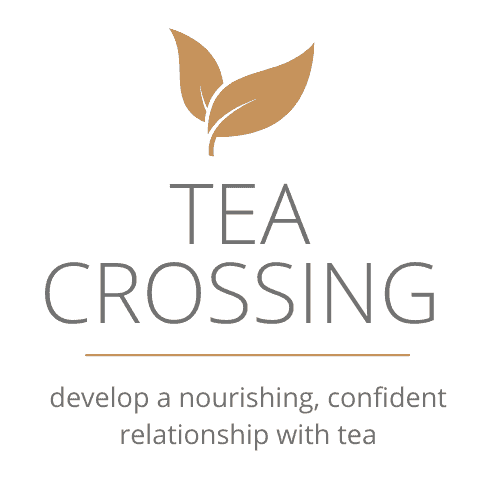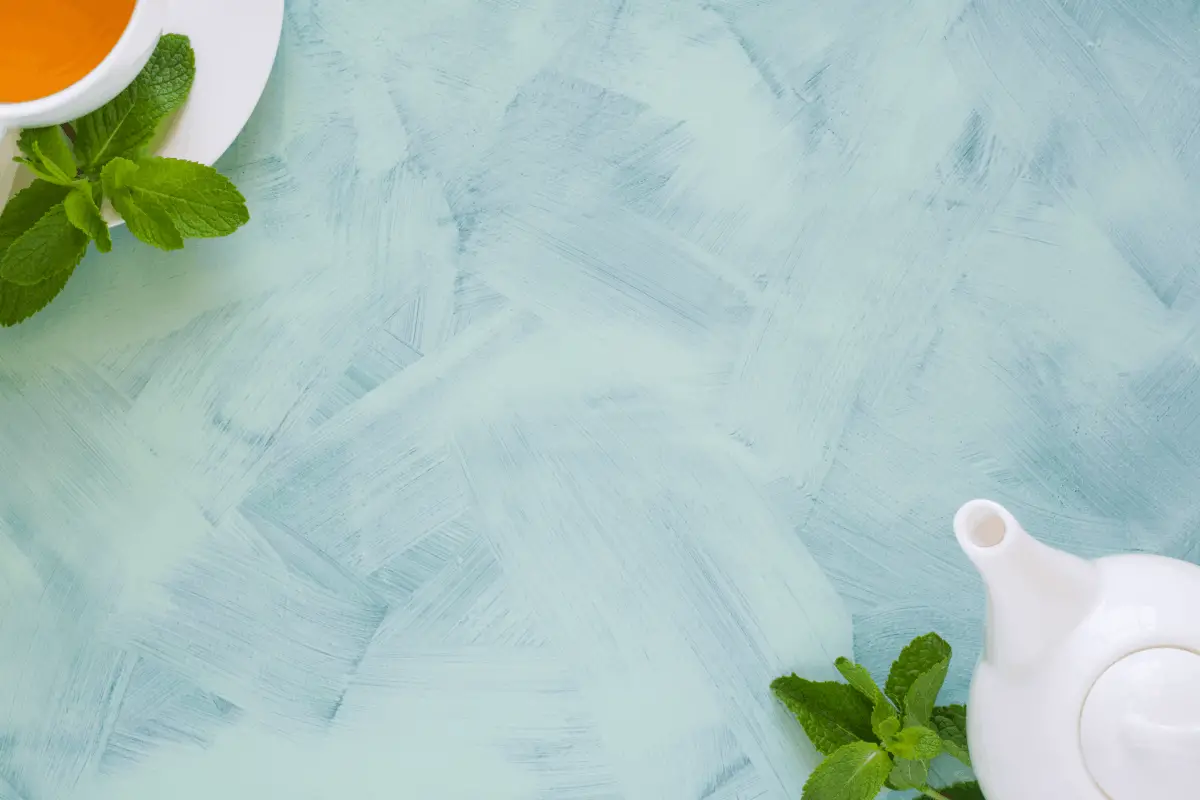When learning about teas, it can be confusing to understand the different types: black, green, white, herbal, and more. Some teas, like mint tea, are green-looking but say “caffeine-free.” Whereas, green teas, which are also green, say they have caffeine. What’s the difference and does it matter to you? It may end up being important if you are trying to avoid caffeine or if you would rather specifically drink an herbal tea as opposed to tea from the traditional tea plant.
Here’s what you need to know.
Mint tea and green tea are not the same, they are two distinct types of teas. Mint tea is an herbal tea made from peppermint and is non-caffeinated. Green tea is a caffeinated tea made from camelia sinesis leaves that have undergone a specific withering and oxidation processes. However, Moroccan Mint Tea is made from both green tea leaves and mint leaves.
While mint tea leaves are indeed green, the two types of teas are remarkably different in their compounds and the way they are produced.
We’ll get into the specifics of what differentiates the two, and just how delicious and healing they are when combined!
What is Mint Tea?
Mint tea is most commonly made with dried peppermint (Mentha x piperita) leaves, but can also be made with spearmint or water mint. It is an herbal tea that has been around for centuries, found across the globe (though is believed to be indigenous to Europe and the Middle East.)
Archeologists discovered dried peppermint leaves in Egypt in the pyramids which date as far back as 1000 BCE. However, peppermint wasn’t documented as a uniquely distinctive kind of mint plant until the 1700s.
Peppermint is a perennial plant with striking bright green leaves and is easily grown in the home. You can cultivate your own organic peppermint leaves for culinary purposes, including using them in your own homemade mint teas!
Herbal teas, like mint tea, often tout a wide range of remedies and healing properties to promote health and wellness.
Read on to learn the many ways mint tea can benefit you!
How to Drink Mint Tea
Mint tea can be served hot or cold. Because it is free from caffeine, it can be enjoyed at any point in the day (and is most especially relaxing in the evening.)
If you’d like to enjoy double mint tea, you can combine peppermint leaves with spearmint leaves, which is one of my personal favorites.
You can also add fresh mint leaves to a cup of dried-leaf mint tea, or you can add fresh mint to any kind of herbal, green or black tea. Combine lemon, lavender and mint for an anti-allergen tea. Or mix peppermint with ginger for a digestion and stomach aid.
Simply pour hot water over a bag of dried mint leaves into a cup and enjoy! You can also add fresh leaves. To do this, slightly crush the leaves to release the natural oils present in the mint plant, and then steep them in the boiled water.
The Benefits of Mint Tea
Mint tea is not only incredibly refreshing, it can act as a health tonic for various ailments or symptoms.

Here are the numerous benefits of drinking mint tea.
- Relieves Upset Stomach Symptoms. Peppermint can soothe the gastrointestinal system. This ranges from easing stomach pangs, heartburn, diarrhea, and most especially relieving gas. Mint tea is also believed to aid in healthy digestion and is recommended as an after-meal drink. Additionally, peppermint oil diluted with oil and water, when ingested, has been found to effectively treat symptoms caused by IBS (Irritable Bowel Syndrome). Since essential oils are merely a more potent form of the leaf compound, the mint tea is therefore assumed to be an effective balm for IBS as well.
- Offers Headache Relief. Healthcare professionals have found that even the aromatic properties of mint tea can help to relieve headaches and tension. Peppermint tea is thought to open blood vessels, which are restricted during the onset of headaches or migraines. Therefore, some recommend reaching for a cup of mint tea as opposed to tossing back painkillers.
- Aids Immune System. Peppermint inherently possesses antiviral and antimicrobial properties. This means peppermint is capable of fighting off bacteria. Ever wonder why your toothpaste is mint flavored? It’s not just because it tastes nice and gives you fresh smelling breath. It’s so your mouth benefits from the microbial properties which helps to kill bacteria in your mouth. Therefore, sipping on peppermint tea during the onset of a cold could help kill bacteria that is trying to make a home in your upper respiratory tract. While there aren’t enough studies to scientifically prove this to be true, the warmth and aroma of the tea itself will certainly leave you feeling more comfortable if nothing else.
- Sharpens Mental Acuity. Ever hear the rumor that chewing mint gum helps one focus during a test? That’s because peppermint helps to wake up the brain and make you more mentally alert! However, gum does not contain enough mint to really pack the punch you’re looking for. A cup of mint tea may do the trick! In fact, some believe its minty kick, despite being caffeine free, can compete against a cup of coffee in the morning.
- Soothes Muscle Cramps. Mint tea has an antispasmodic effect on the body thanks to the menthol present in the tea. This helps to ease muscle tension and constriction. Some find it especially affective for relieving menstrual cramping!
Types of Mint Tea that are Combined with Green Tea
One of the most popular types of mint tea is Moroccan mint tea (also known as Maghrebi mint tea.) Moroccan mint tea is made with both green tea and fresh spearmint leaves, combined with sugar and served hot. If you’ve never tried it before, it is sweet, delicious and warming! You may want to try a box of this Organic Green Tea with Moroccan Mint.
“While mint tea leaves are indeed green, the two types of teas are remarkably different in their compounds and the way they are produced.”
TEA CROSSING
What is Green Tea?
Green tea is made from the camellia sinesis plant leaves and buds. The distinctive green tea process has been perfected over centuries and undergoes a similar withering and oxidation process used when making black, white, or oolong teas.
Green tea originated in China, however, it is now currently produced in many countries in East Asia. There are many green tea varieties. These diverse types vary based on the type of camellia sinesis used, how it was grown, how it is processed, and at which time it was harvested.
How to Drink Green Tea
Most green teas are made from dried leaves, which either come in pre-packaged tea bags, or come loose leaf. Boil water, add the tea bag, and enjoy! (Caution: if you steep green tea too long, or in too hot of water, it can become very bitter.)
Green tea is also delicious as a cold beverage on ice. Green tea is also tasty as a latte, when made with milk (especially when using matcha green tea.)
What is Matcha Green Tea?
Matcha is a Japanese green tea. It is made from a leaf called tencha, which is plucked, processed and then ground into a very fine powder (known as matcha). Matcha tea is used in traditional Japanese tea ceremonies and is prepared by whisking tea in boiled water in a bowl, until the tea is frothy. Matcha is a sweeter green tea, though can turn bitter if it is combined with water that is too hot.
What are the Benefits of Drinking Green Tea?
Most famously, green tea is touted for its healing properties and beneficial compounds.
While more clinical research is needed to fully support some of the claims, current evidence-based research says that green tea shows a lot of promise for keeping us healthy. In addition, anecdotal reports of health benefits are widely accepted.

Here are some of the top potential benefits of drinking green tea:
- Improves Cardiac Health. Some studies found a minor correlation between drinking one cup of green tea per day and a lowered risk of cardiovascular disease. Not only that but drinking a cup a day for 3-6 months may also lower systolic and diastolic blood pressure.
- May Prevent Type 2 Diabetes. Green tea seems to have a stabilizing effect on insulin sensitivity and blood sugar levels. In fact, several studies have demonstrated an 18% reduction in diabetes risk levels for green tea drinkers.
- Lowers Cholesterol. Drinking green tea or taking green tea leaf supplements may lower cholesterol.
- Acts as an Anti-Inflammatory. There is some evidence that green tea can aid in relieving inflammation in the body.
- Boosts Brain Function. Green tea contains both caffeine and L-theanine, which in combination can have synergistic effects. The synergy between the two compounds gives brain power and alertness a boost. In fact, green tea has even shown itself to slow down brain aging.
- Offers Healthy Antioxidants. Green tea is packed with antioxidants which can help to prevent against diseases such as cancer. In fact, some studies indicate that regular green tea drinkers have a lower risk of many types of cancers.
- May Help with Weight Loss. Most current weight-loss aids list green tea as an ingredient. The caffeine in green tea may be primarily responsible for the results, but it also seems to boost the metabolic rate in ways we are still researching.
The Key Differences Between Green and Mint Tea
Mint tea and green tea are equally delicious and popular drinks. Though they are made from entirely different plants, have different properties, and are enjoyed in different manners, they are tasty when combined.
If you are looking to enjoy something aromatic, herbal, and caffeine free, mint tea is an ideal choice.
If you’d like something with a little bitter-kick and has that boost of caffeine, green tea is the way to go.

